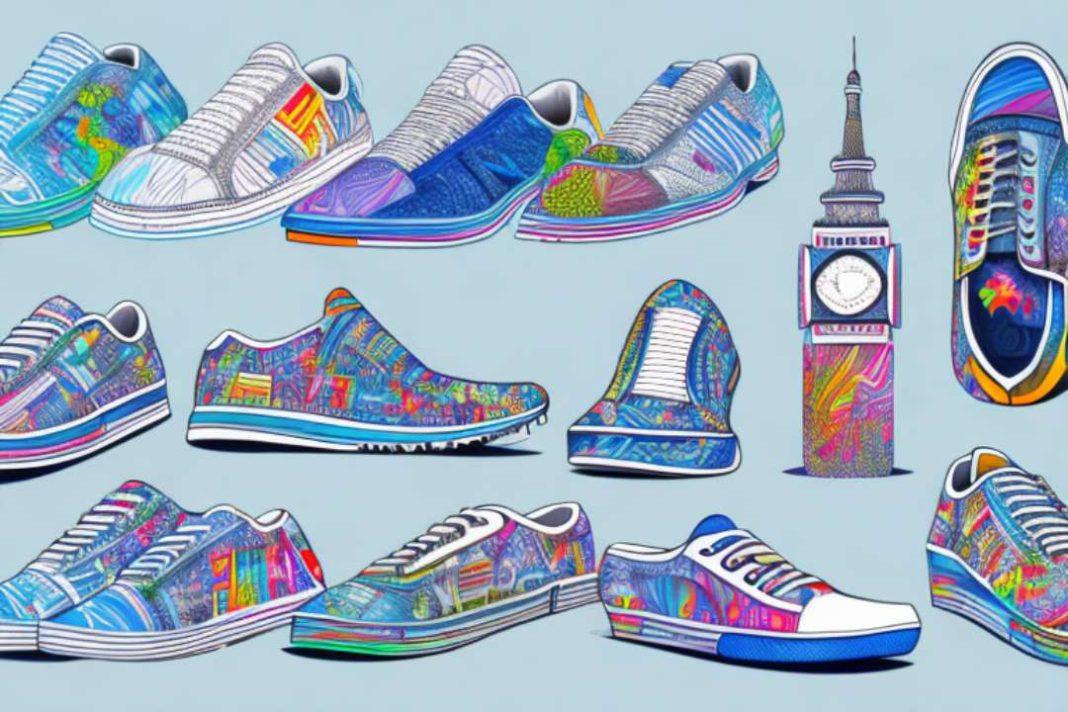Sneakers have come a long way since their inception as athletic shoes. Today, they have become a global fashion phenomenon that dominates both the high-end luxury market and the mass consumer market. This article explores how sneakers have evolved over the years, from their humble beginnings to their current status as a multi-billion dollar industry.
The Evolution of Sneakers
Early Beginnings: The Birth of Athletic Shoes
The first sneakers were developed in the 19th century as simple, rubber-soled shoes that were primarily used for sports and exercise. These early sneakers were made of canvas and had a thin rubber sole, which provided extra traction and support for athletes. However, they were not yet considered fashionable and were primarily worn for their practical benefits.
It wasn’t until the 20th century that sneakers began to gain popularity as a fashion item. In the 1920s, Converse released the famed Chuck Taylor All-Stars, which were worn by basketball players and quickly became a hit with consumers. This marked the beginning of the sneaker’s transformation from a purely functional item to a must-have fashion accessory.
The Rise of Sneaker Culture in the 1980s
The 1980s marked a pivotal moment in sneaker history. The emergence of hip-hop and streetwear culture meant that sneakers were no longer just for athletes but had become a symbol of status and identity. Sneaker brands began to create limited-edition releases, which quickly sold out and became highly sought-after collector’s items.
Nike’s Air Jordan line, which launched in 1985, was one of the key drivers of this trend. The shoes were designed in collaboration with basketball superstar Michael Jordan and quickly became a cultural phenomenon. Celebrities and athletes alike were seen wearing Air Jordans, and the shoes became a symbol of coolness and exclusivity.
The Influence of Hip-Hop and Streetwear
As hip-hop and streetwear culture continued to gain popularity in the 1990s and 2000s, the demand for exclusive sneakers grew. Sneaker brands began to collaborate with streetwear labels and fashion designers, creating limited-edition releases that were only available at select retailers.
The emergence of social media further fueled the hype around limited-edition sneaker releases. Sneakerheads, as fans of exclusive sneakers are known, would post photos of their latest acquisitions on social media, driving up demand even further.
The Emergence of High-End Designer Sneakers
The early 2000s saw the rise of designer sneakers, as luxury brands like Gucci, Prada, and Balenciaga entered the market. These high-end sneakers were made with premium materials like leather and suede and featured distinctive designs that set them apart from traditional athletic sneakers.
Designer sneakers were embraced by both the fashion community and the sneakerheads, including sneaker reps, who recognized their exclusivity and high price point as a sign of prestige. Today, high-end designer sneakers, sought after by sneaker reps, are some of the most coveted and expensive sneakers on the market.
Key Players in the Sneaker Industry
Iconic Brands and Their Impact
There are several major sneaker brands that dominate the market, including Nike, Adidas, Reebok, and Puma. These brands invest heavily in marketing and innovation, constantly releasing new products and collaborations to stay ahead of the competition.
Nike is one of the most iconic sneaker brands, known for its innovative designs and marketing campaigns. The brand has a long history of collaborating with athletes, musicians, and artists to create unique and exclusive sneakers. One of Nike’s most successful collaborations was with basketball legend Michael Jordan, which led to the creation of the iconic Air Jordan line.
Adidas has also made a resurgence in recent years, thanks in part to its Boost technology and collaborations with high-profile celebrities like Kanye West. The brand has also made a commitment to sustainability, introducing eco-friendly materials and production methods to its products.
Reebok and Puma may not have the same level of market dominance as Nike and Adidas, but they have still managed to make their mark in the industry. Reebok has collaborated with streetwear labels like Palace and Vetements to create unique designs, while Puma has partnered with Rihanna to create a successful line of women’s sneakers.
Celebrity Endorsements and Collaborations
Celebrities have played a major role in the sneaker industry, with many partnering with brands to create exclusive designs and limited-edition releases. From Michael Jordan and Nike to Kanye West and Adidas, celebrity collaborations have driven up demand and created a buzz around new releases.
However, collaborations with celebrities have not been limited to sports and streetwear brands. Luxury fashion houses like Chanel and Louis Vuitton have also entered the sneaker market, collaborating with artists and designers to create high-end sneakers that are sold at premium prices. These collaborations have helped to blur the lines between high fashion and streetwear, creating a new wave of luxury sneakerheads.
The Role of Influencers and Social Media
In recent years, the rise of social media influencers has had a major impact on the sneaker industry. Influencers with large followings on platforms like Instagram, YouTube, and TikTok have the power to drive up demand for new releases and create a buzz around exclusive sneakers.
Brands often partner with influencers to promote their latest releases, providing them with early access to exclusive designs and inviting them to events and launch parties. This has created a new wave of sneakerheads who are driven by hype and exclusivity. However, some critics argue that this focus on hype and exclusivity has taken away from the true purpose of sneakers, which is to be worn and enjoyed.
Despite these criticisms, it is clear that the sneaker industry will continue to be shaped by iconic brands, celebrity collaborations, and the influence of social media. As consumers become more conscious of sustainability and ethical production methods, it will be interesting to see how brands respond and adapt to meet these changing demands.
The Sneaker Market and Economy
The sneaker industry has come a long way since its humble beginnings as functional athletic footwear. Today, sneakers are a fashion statement and a status symbol, with some rare and limited-edition releases selling for thousands of dollars. In this article, we will explore the growth of the sneaker resale market, the impact of limited edition releases and hype culture, and the ongoing battle against counterfeit sneakers.
The Growth of the Sneaker Resale Market
In recent years, the sneaker resale market has exploded in popularity. Websites like StockX and GOAT have made it easier than ever for sneakerheads to buy and sell exclusive sneakers, driving up demand for rare and limited-edition releases.
The resale market has also created a new business opportunity for entrepreneurs who buy and resell sneakers for a profit. This has led to a growing community of sneaker resellers who are constantly on the hunt for the next big release. Some have even turned their passion for sneakers into full-time careers, building successful businesses around buying and selling exclusive footwear.
However, the sneaker resale market has also sparked controversy, with some arguing that it has contributed to the commodification of sneaker culture. Critics argue that the focus on rare and exclusive releases has shifted the focus away from the functional aspects of sneakers and towards their status as luxury items.
Limited Edition Releases and Hype Culture
The sneaker industry has become a master of creating hype around limited-edition releases. Brands will often keep details of new releases under wraps until just before the launch, creating a buzz of anticipation among fans.
Some releases are so highly anticipated that they sell out within minutes, with fans camping out in front of stores or refreshing websites in the hopes of snagging a pair. This has created a competitive buying culture, with some fans resorting to bots or other tactics to improve their chances of securing a pair.
Several brands have even gone as far as to create fake releases or announce shock drops, further driving up demand and creating a sense of urgency among fans. This has led to a culture of hype and exclusivity, with some fans willing to pay exorbitant prices for rare or limited-edition releases.
The Impact of Counterfeit Sneakers
Counterfeit sneakers are a major problem in the sneaker industry, with fake versions of popular designs flooding the market. These sneakers are often made with inferior materials and can pose a safety risk to consumers.
Several major brands have taken steps to combat the counterfeit market, including implementing new technologies and partnering with law enforcement agencies to crack down on fake sneakers. However, counterfeiters continue to find new ways to produce and distribute fake sneakers, making it a continuous challenge for the industry.
Counterfeit sneakers not only hurt consumers who may unknowingly purchase fake products, but also impact the bottom line of legitimate sneaker brands. The sale of counterfeit sneakers takes away from the revenue of the legitimate brands, and can also damage their reputation if consumers associate them with poor quality or safety concerns.
Overall, the sneaker industry is a complex and ever-evolving landscape, with the growth of the resale market, hype culture, and counterfeit sneakers all playing a significant role. As the industry continues to evolve, it will be interesting to see how it adapts to these challenges and continues to thrive.
The Intersection of Sneakers and Sustainability
The Environmental Impact of Sneaker Production
The sneaker industry has come under scrutiny in recent years for its impact on the environment. The production of sneakers requires significant amounts of water, energy, and resources, and the use of synthetic materials can have a negative impact on the environment.
Several sneaker brands have taken steps to address these concerns, including using sustainable materials and reducing their carbon footprint. Some companies have even created innovative materials like Mycelium, a leather substitute made from mushroom roots.
Sustainable Sneaker Brands and Initiatives
Several sustainable sneaker brands have emerged in recent years, using eco-friendly materials and production methods to create sneakers that are both stylish and sustainable. These brands include Allbirds, Veja, and Rothy’s, among others.
Meanwhile, the circular economy movement has inspired initiatives such as sneaker recycling programs, where used sneakers are collected and either repurposed or recycled into new products.
The Future of Eco-Friendly Sneakers
The demand for sustainable sneakers is expected to grow in the coming years, as consumers become more environmentally conscious and seek out products that align with their values. The sneaker industry will need to continue to innovate and find new ways to create eco-friendly sneakers while still meeting the demands of the market.
Conclusion
From their origins as simple athletic shoes to their current status as a multi-billion dollar industry, sneakers have undergone a remarkable transformation over the years. The sneaker industry continues to innovate and evolve, driven by a deep passion and creativity for the culture of sneakers. As sustainability concerns become more pressing, the industry has also begun to embrace eco-friendly materials and initiatives, signalling a new chapter in the evolution of sneakers.





